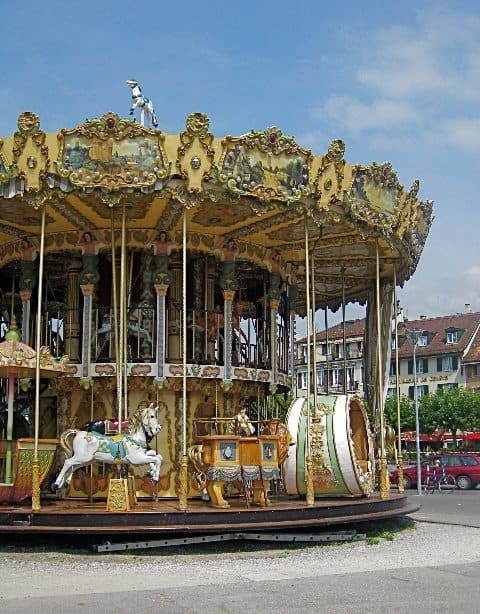
Vevey, Switzerland is another beautiful town gracing the shoreline of Lake Geneva. It is much smaller than Lausanne but sounded just as picturesque when described in the travel guides I was reading. One early afternoon, as I took the train back to Lausanne, I thought it would be fun to get off at Vevey and have a look around. I wanted to see what the town was like, perhaps visit a museum or two or check out the local market that I had read was held on Tuesdays.
Exiting the station at Vevey I headed down the hill toward the lake. Soon I found myself at the Grande-Place (Place du Marché) market square. What I didn’t find was a market but only a large paved area. Perhaps I arrived too late in the day. Perhaps I was misinformed. It didn’t really matter. My eye was drawn down the hill to an intriguing old double decker carousel situated beside the market square toward the lake. Just past the carousel the lake front opened up to a lovely promenade stretching out beside the water in both directions. Small outdoor kiosks and cafés were nestled alongside and swans floated dreamily near the shore under a brilliant blue sky.
The Promenade
The promenade beckoned. I walked past the empty market area and the carousel and continued down the path beside the lake. It was a beautiful afternoon and people were out making the most of it. I passed couples holding hands, tourists taking photos and an older gentleman at an easel on the sidewalk painting a view of the town.
I hoped to find one of several interesting museums I had read about. The signpost for museums pointed this way so I continued walking, basking in the elegant yet relaxed beauty of this place. I watched sailboats glide across the shimmering water, saw children playing in a grassy space and photographed some of the beautiful flowers along the promenade.
Soon enough I saw something rather unusual up ahead. Along the promenade and just into the lake I saw a huge fork sticking up out of the water. I thought it must be a sign that I had found the Alimentarium (or Musée de l’Alimentation), a food museum sponsored by Nestlé whose international headquarters happen to be in Vevey.

The Alimentarium
Across the street I found the building, paid my admission and entered. Inside were four large galleries featuring different aspects of food – digesting, purchasing, eating and cooking – and a large area for special exhibitions upstairs. The signage in the main galleries was in English as well as French and German so I was able to follow the exhibits and enjoy the displays.
The museum was well laid out and housed a variety of exhibits. I especially enjoyed looking through the eating gallery. There I found several displays concerning the history of food. They offered some interesting observations about how food traditions have changed over time.
One display observed that while the Advent season in December was traditionally a time of restriction and preparation for the Christmas season, now December is simply the herald of winter and treats of all kinds are prepared, sold and consumed throughout the month.
Another pointed out that the third Sunday in September had been declared a day of thanksgiving, penitence and prayer by the Swiss assembly of cantons in 1832. It was known as the Federal Day of Fasting and yet, in time, no one fasted anymore. In 1970 it was decided to replace the act of thanksgiving and fasting with a project to collect money for mutual-aid. Now the day is celebrated by eating plum tarts.
My favorite display, featuring a bunny made of bread, noted, “In paradise, trees are in flower and in fruit together – there are no seasons. Paradoxically, now that produce is available all year round, there is a growing urge to eat according to the season.”
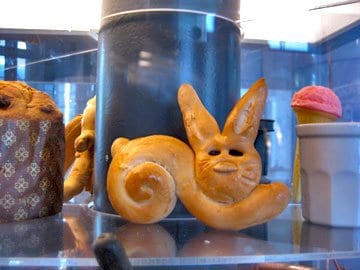
Still my favorite section of the museum was the gallery on cooking. It featured a working kitchen area where interactive cooking demonstrations were offered several times a day. As I entered this section I saw a workshop in progress and it looked both fun and informative. “Too bad I missed it,” I thought, as I saw that they were close to being finished with their choux pastry rolls. Then I noticed that another class was to begin in about half an hour.
Choux Pastry Workshop
I have loved choux pastry since I first sampled it freshly made and hot from the oven. My oldest son used to cook quite often and sometimes he would make Profiteroles and serve them fresh, with ice cream and his own special chocolate sauce. They were wonderful, and yet I somehow imagined that they were very difficult to make and never tried them for myself. But there is a time for everything. I began to think how perfect it would be to try making them here and bring that experience home from Switzerland as a souvenir. With someone to guide me in person I felt confident that I could do it.
Finally I got up the nerve to ask if I could participate. The workshop was presented in French only but I thought I would be able to follow it. I just didn’t want anyone to get frustrated by my mistakes or my camera. Happily I was encouraged to participate and after paying a small fee I hurried in to get ready for the workshop.
As the class began we put on our ‘Alimetarium’ aprons. I soon found that of the eight or so other participants in this workshop more than half were children. And why not? The recipe turned out to be simple enough. I also found that the other participants spoke a variety of languages. The boy beside me, my station partner, helped me to understand the instrutions with gestures and a few words of English. What’s more, the chef’s assistant knew English and was kind enough to translate for me whenever the chef explained details beyond the basic recipe and techniques, or told something very interesting about the history or potential of Pâte à Choux. I was touched by their effort to help me overcome my language limitations and make the most of the class.
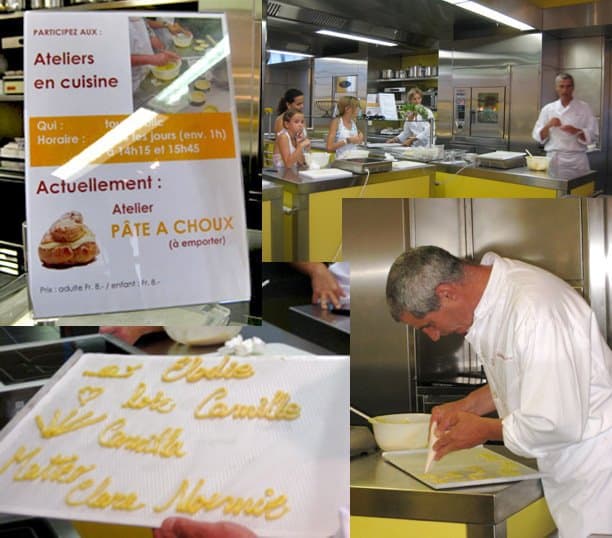
History and Chemistry
The chef spoke briefly about the origins and history of choux pastry. It had to do with Catherine de Medici and her court chefs as well as something about the terminology that evolved. I think it is an interesting story though I couldn’t completely follow the details at the time.
He also talked about it’s chemistry. He asked what makes choux pastry rise and become hollow inside when it consists of only basic ingredients and no baking powder or other leavening? The answer is steam. Because of the high ratio of eggs to flour, the egg proteins provide shape but remain stretchy. When the liquid in the recipe comes in contact with the heat of the oven it turns to steam which expands the roll from the inside causing it to puff outward and creates a hollow shell. This shell, when opened, can be filled with all sorts of good things. The chef also showed us how to form a pastry bag from parchment paper and then he piped the names of some of the workshop participants along with other shapes to show us how fun it could be to work with Pâte à Choux.
Along the way we created our own bits of choux pastry in teams of two and ended up with two different choux pastry appetizers packed in pretty boxes and bags to take home. We also took home a copy of the recipe. Luckily, though it was written in French, the recipe is rather short and simple and I have made an attempt to translate it here for you. I tried it at home to make sure I didn’t miss anything. The result was some delicious little cheesy rolls that my family gobbled up.
The recipe we used in class was for eight choux pastry puffs. It is a good amount for a demonstration but I would usually want to make more. Today I doubled the amount and that is what I will write below. You may want to double it again if you are serving guests. Do remember though, choux pastry puffs are best served when cooled only slightly and then served fresh. For that reason I suggest making only the quantity you plan to eat within a few hours. Luckily, it is an easy recipe and you can simply make more for the next time.
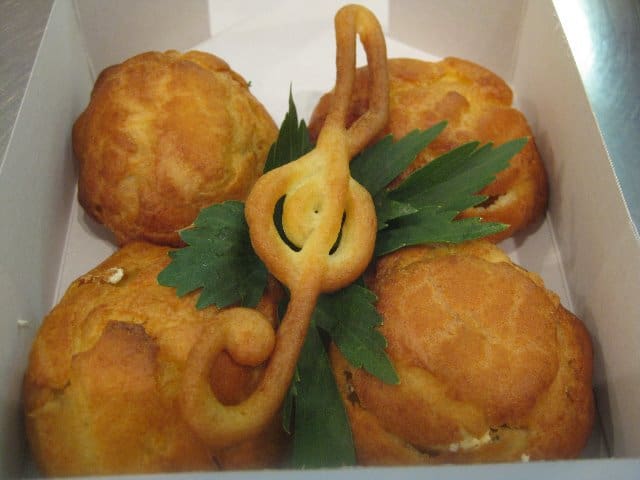
Cheesy Pâte à Choux
(recipe from the Alimentarium Workshop)
1/2 cup water
1/4 cup butter
1/4 teaspoon salt
1/2 cup flour
2 eggs, beaten
1/2 cup grated Gruyère cheese (optional)
Place the water, butter and salt in a small saucepan over medium heat. Stir until the butter is melted and the water is boiling.
Add the flour all at once stirring to combine. Continue to cook, stirring constantly with a wooden spoon, until the mixture begins to pull away from the sides of the pan.
Remove from heat and cool slightly.
Add eggs gradually in several parts, stirring well after each addition, to form a paste.
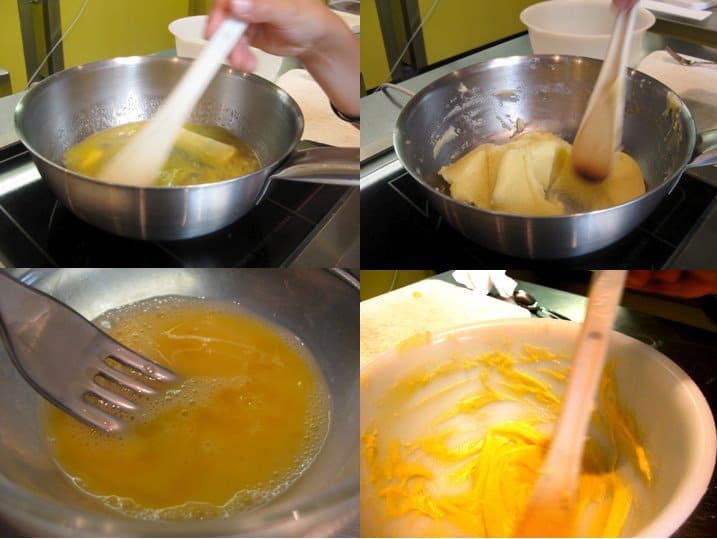
Add the cheese, if desired.
Using two spoons scoop teaspoon sized dollops of the dough onto a cookie sheet lined with parchment paper, spacing them 2 inches apart.
Bake in a hot oven.
Note: At home I baked them at 375 degrees F for approximately 20 -25 minutes, or until golden brown. Some choux pastry recipes use higher baking temperatures, up to 250C which is over 475F. These call for baking times more like 15 – 20 minutes. If I am reading the recipe from the Alimentarium correctly it calls for placing the puffs in an oven preheated to 100C, or around 250F. After placing the pastry in the preheated oven, immediately turn the temperature up to 250C, or 450F. Then bake until golden, 15 to 17 minutes.
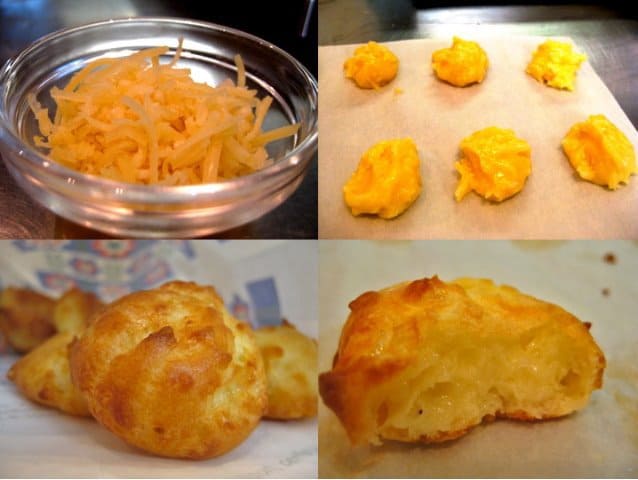
Another way to make these is to leave the cheese out of the pastry dough and scoop tablespoon sized dollops onto the parchment paper about 2 or 3 inches apart.
Continue as directed above. When the puffs are golden remove them from the oven and let them cool slightly.
While they are cooling prepare a mixture of:
1 8-ounce package of cream cheese
2 Tablespoons grainy mustard
2 Tablespoons of your choice of fresh herbs
(the recipe suggested tarragon, chives, chervil, parsley or lovage)
Mix these ingredients until well combined.
Cut the tops from the pastry puffs carefully and scoop some of the cream cheese mixture inside. Cover with the pastry top and serve.
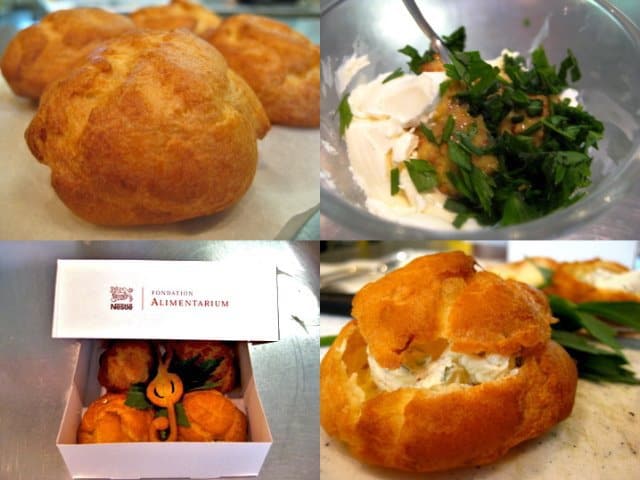
We made both types of savory appetizers in our workshop. My favorite were the ones made with Gruyère cheese. The assistant to the chef told me to make these quite small. Then she told me that in Switzerland just past 5pm, which was fast approaching at the time, these would be delicious with the local white wine for apéritifs.
She also suggested that if I made these at home the dough should be prepared and arranged on a baking pan in advance and then as soon as the guests arrive should be popped in the oven for a warm delicious appetizer.
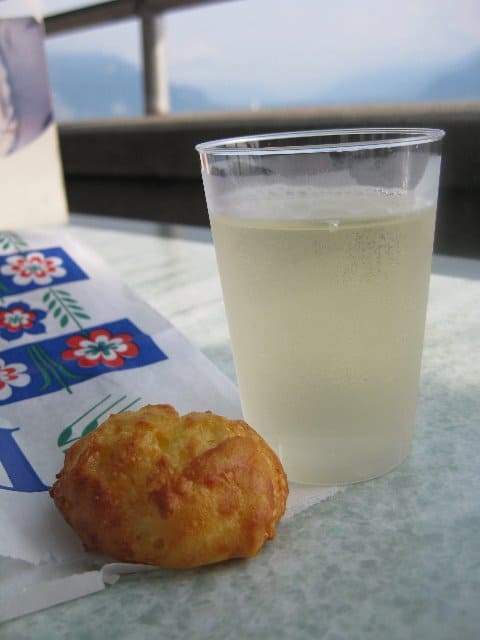
Eager to try her advice I stopped for a glass of white wine along the promenade on the way back to the boat dock and sampled my Gruyère Choux Puffs. Delicious! When I had finished I caught the boat back to Lausanne feeling good about the day.
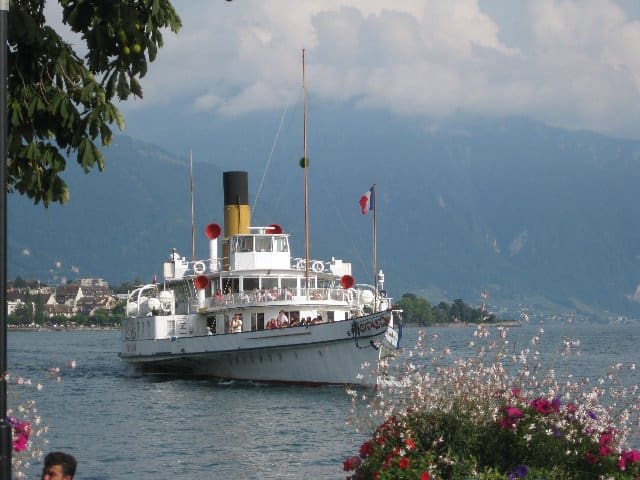


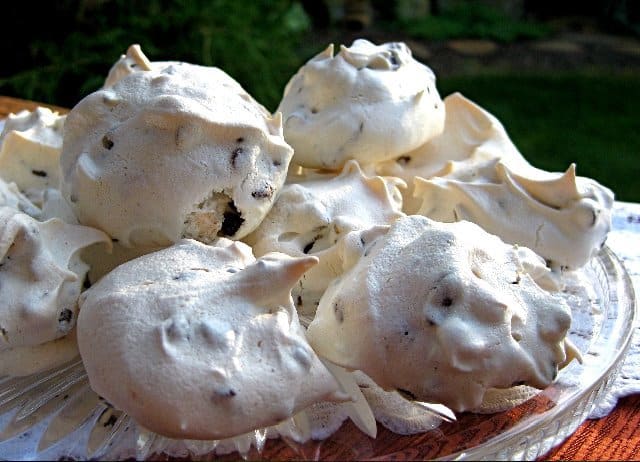




I, too, languished in this wonderful account of a delightful trip to Vevey. I also hastily jotted down the choux recipe. Although English, we are living in Geneva, and shall be fortunate enough to be taking my three young children to experience this glorious part of Europe tomorrow. How lucky are we?! Nestle Chocolate Factory is also beckoning. Thank you for sharing your experience – it whetted our appetite.
That for statue is brilliant!
I really love this post, and wish I could have come with you to the choux workshop.
Paula – That workshop really was a great experience! Sometimes we are too willing to give French-speaking Europe a bad rap for their attitude toward Americans who do not speak the language. I have had discouraging experiences but the times when the language gap is successfully bridged more than make up for it. It is so worth it to keep trying, whether the subject is communication, pastry or whatever else might come to mind.
Grace – I wish I were that clever, like this fork photo I found at Dessert Comes First. I am always seeing other people’s photos and thinking “Why didn’t I think of that?”
Ivy – The fork was cool! You can hardly help but smile at something like that, it was so unexpected and yet obvious…
Kristen – Thank you!
Louisa – I love that Corinne Bailey Rae song. In fact it was on my Pi Day Playlist. I have learned that choux pastry is not nearly as tricky as I had imagined, while pie pastry is still pretty much a mystery to me. lol!
Thanks for stopping by!
yes, great post. The instruction and photos of choux pastry are really well done. What a fun time! There’s a funny song by Corine Bailey Rae called “Choux Pastry Heart”. Pretty cute.
How cool is this? What an informative post!
That fork statue is too cool.
I love the fork in the lake. That’s so cool!
at first i thought the giant fork was some sort of trickery on your part. since it’s not, i can safely say AWESOME. i’ve added that the ever-growing list of things to see before i croak. 🙂
Oh, this was a wonderful post! I feel like I just traveled to the other part of the globe! That fork sticking out of the water would catch the attention of every passer-by. The bunny looks amazing to me, and I love the quote about there being no seasons in paradise and the trees flower and fruit at the same time. How gutsy to be so spontaneous and join in the class! That pastry looks outstanding. I enjoyed the history behind it, as well as the science involved. I love gruyere cheese, too. The view from your vantage point was so lovely. Great post! Thanks, too, for visiting my blog!